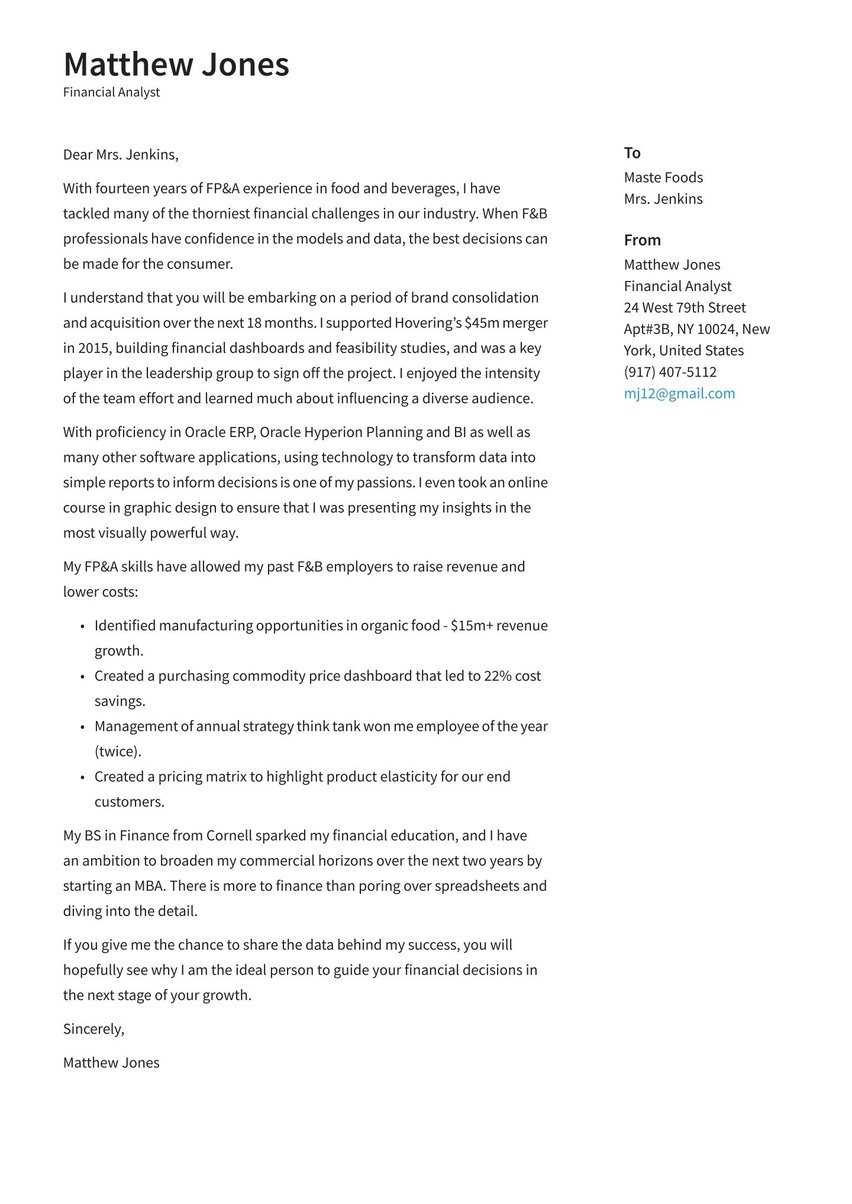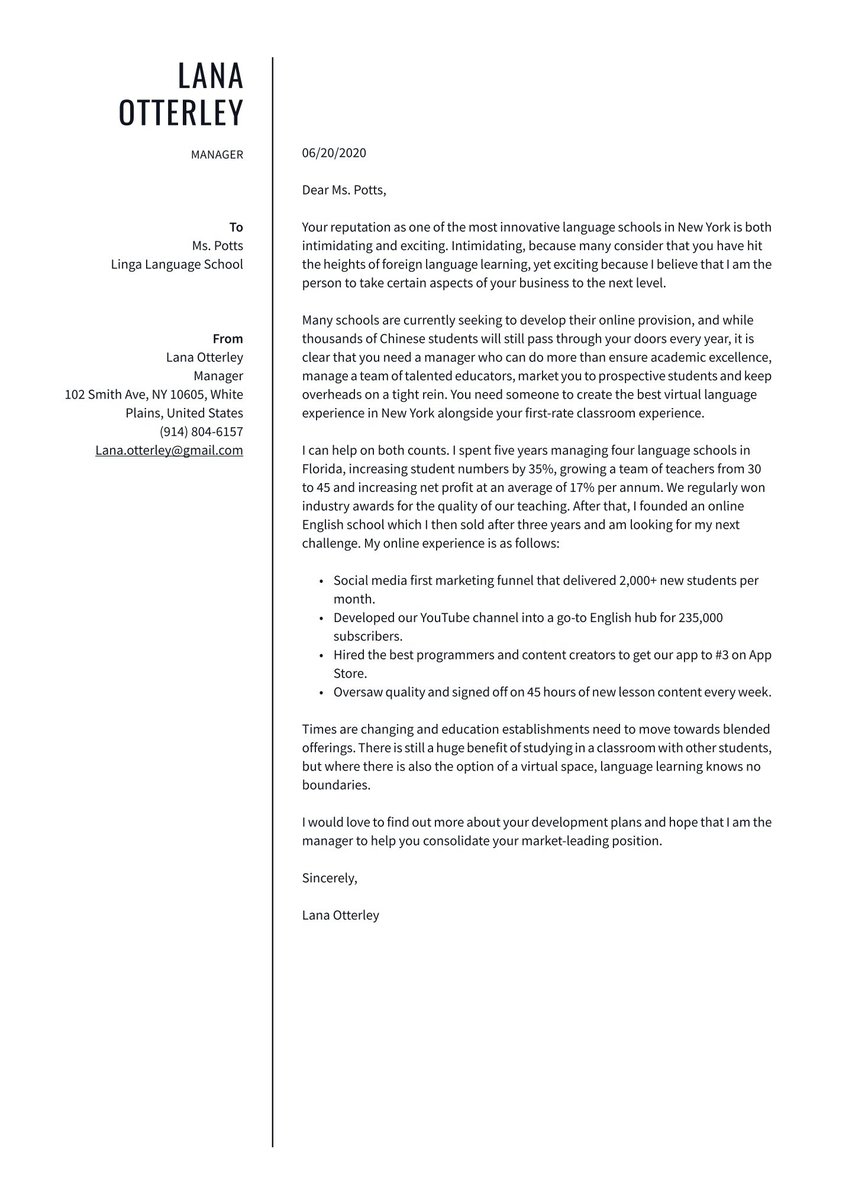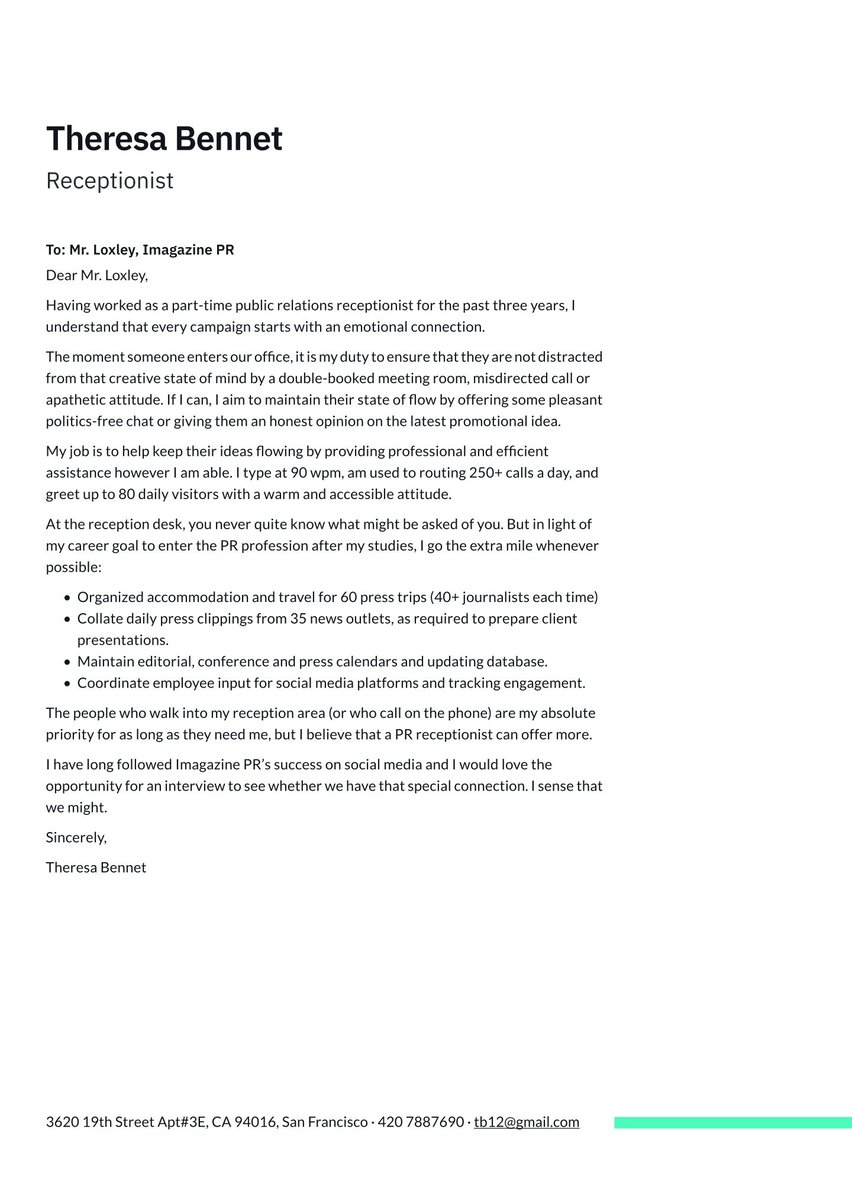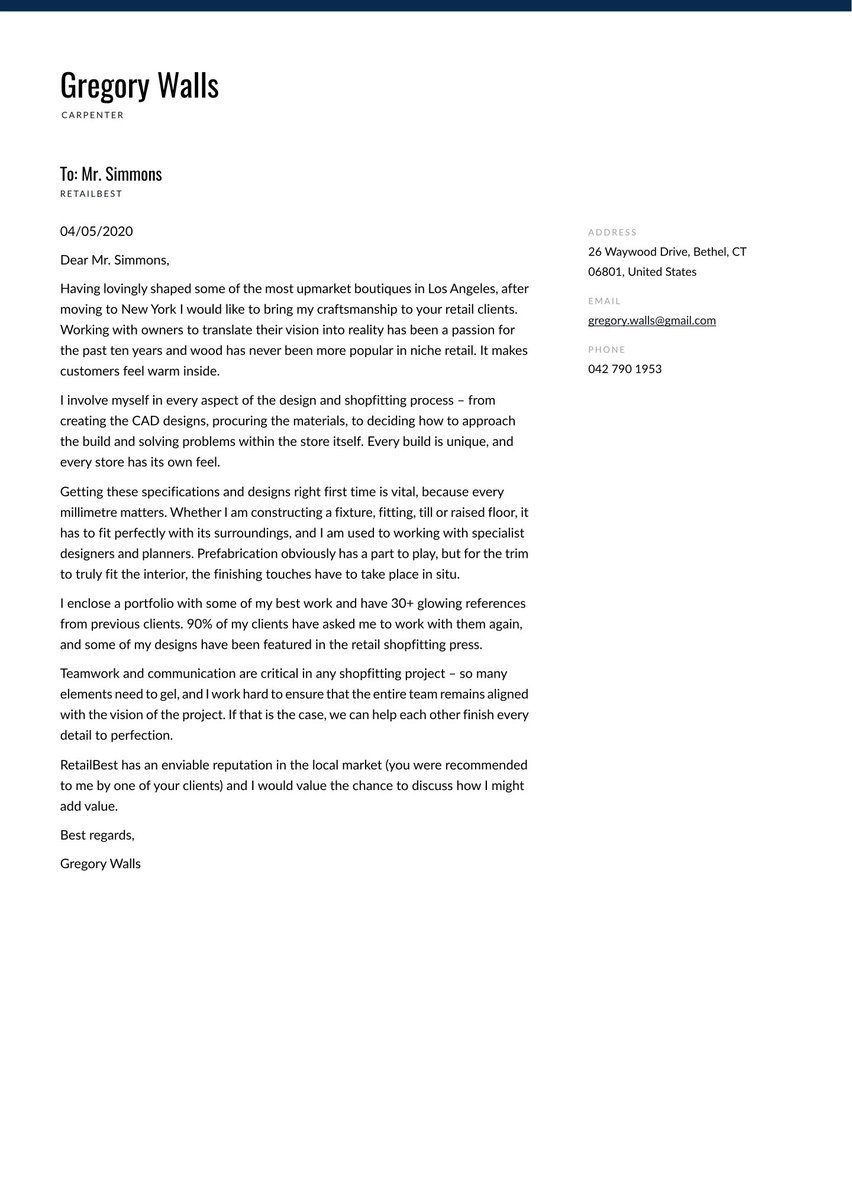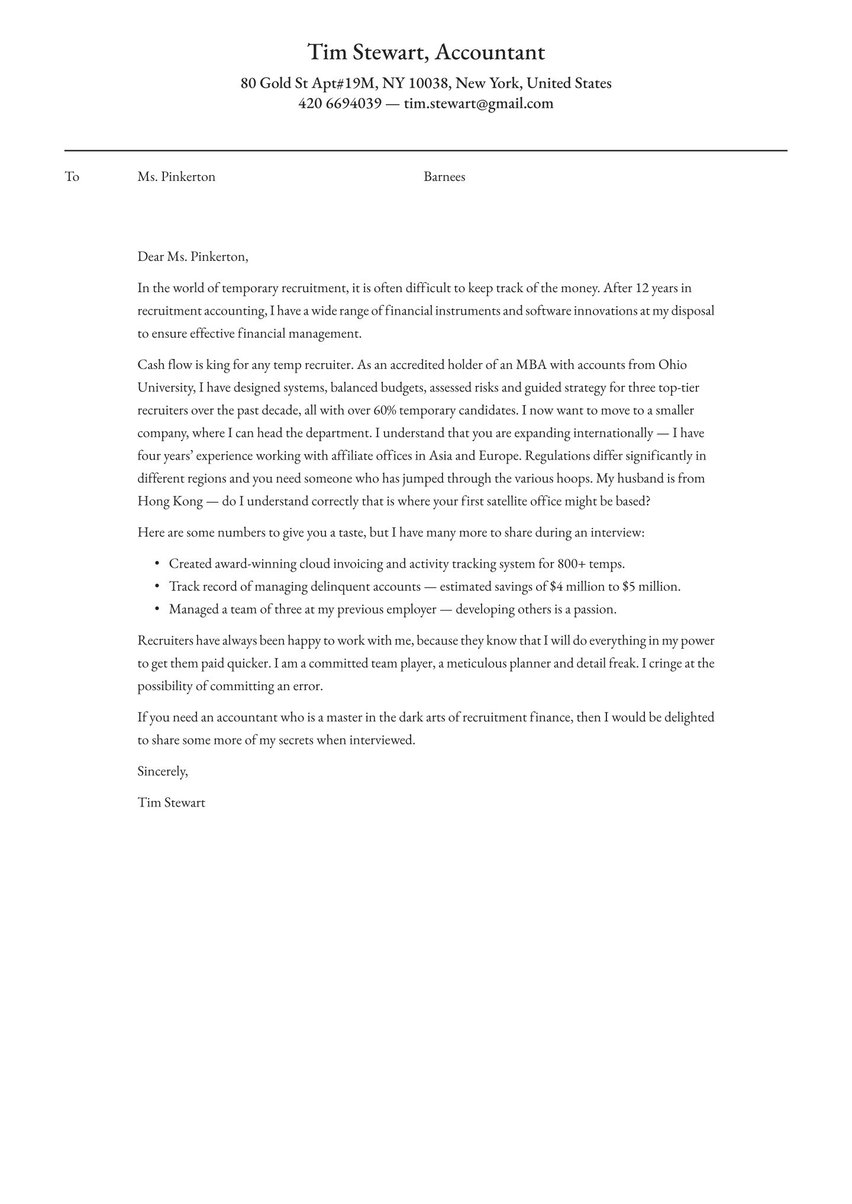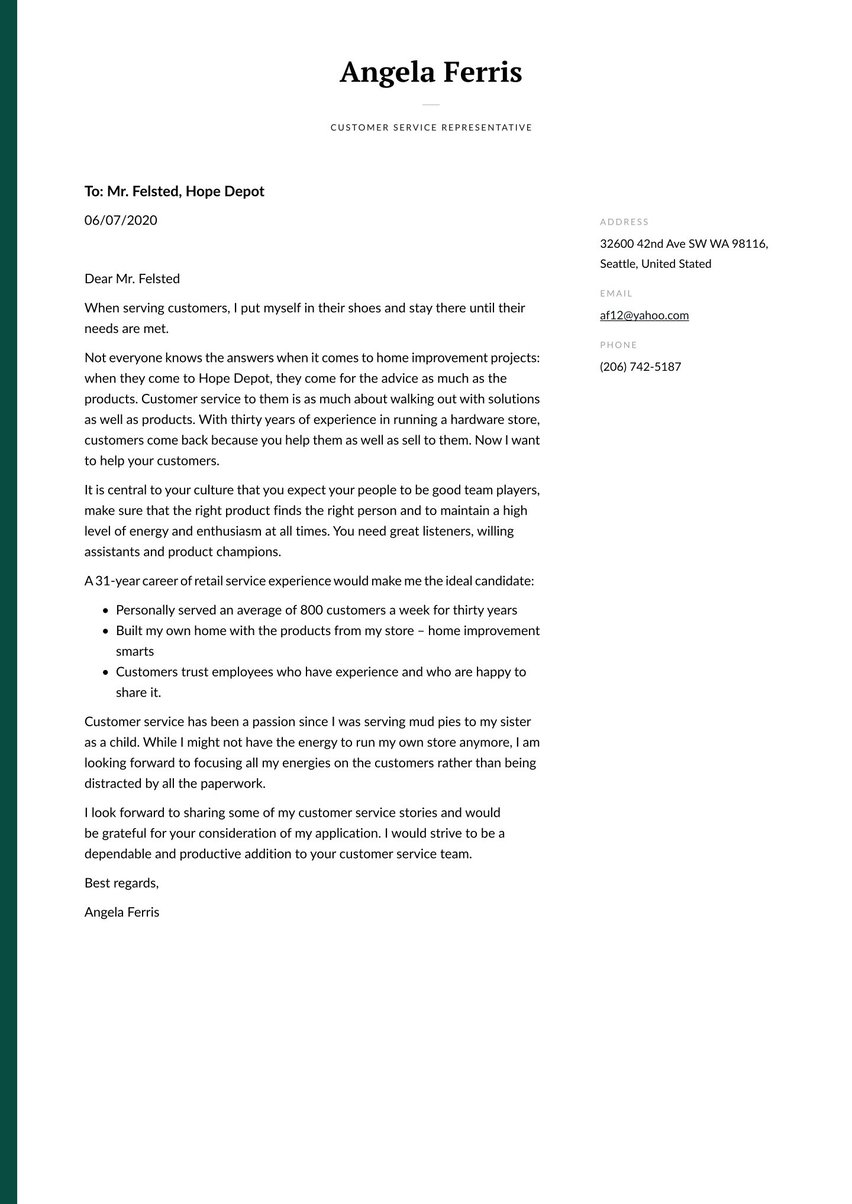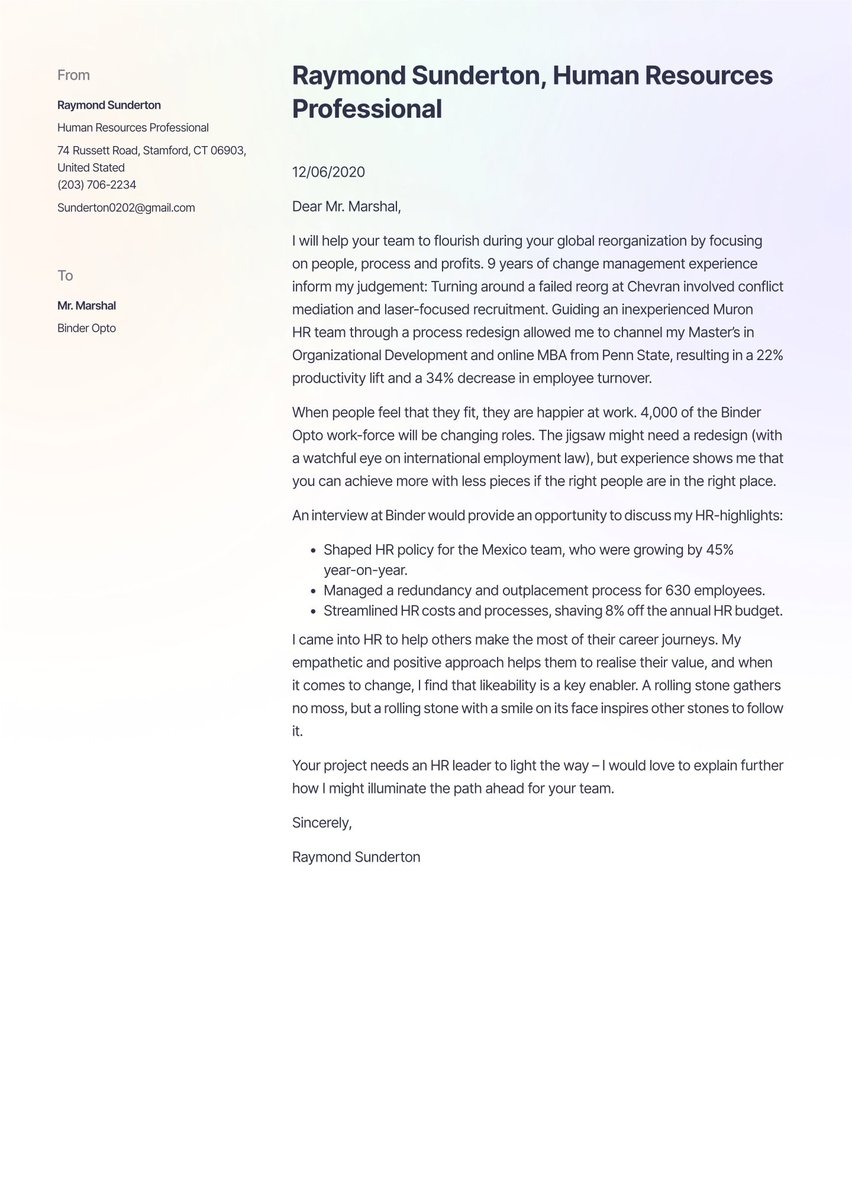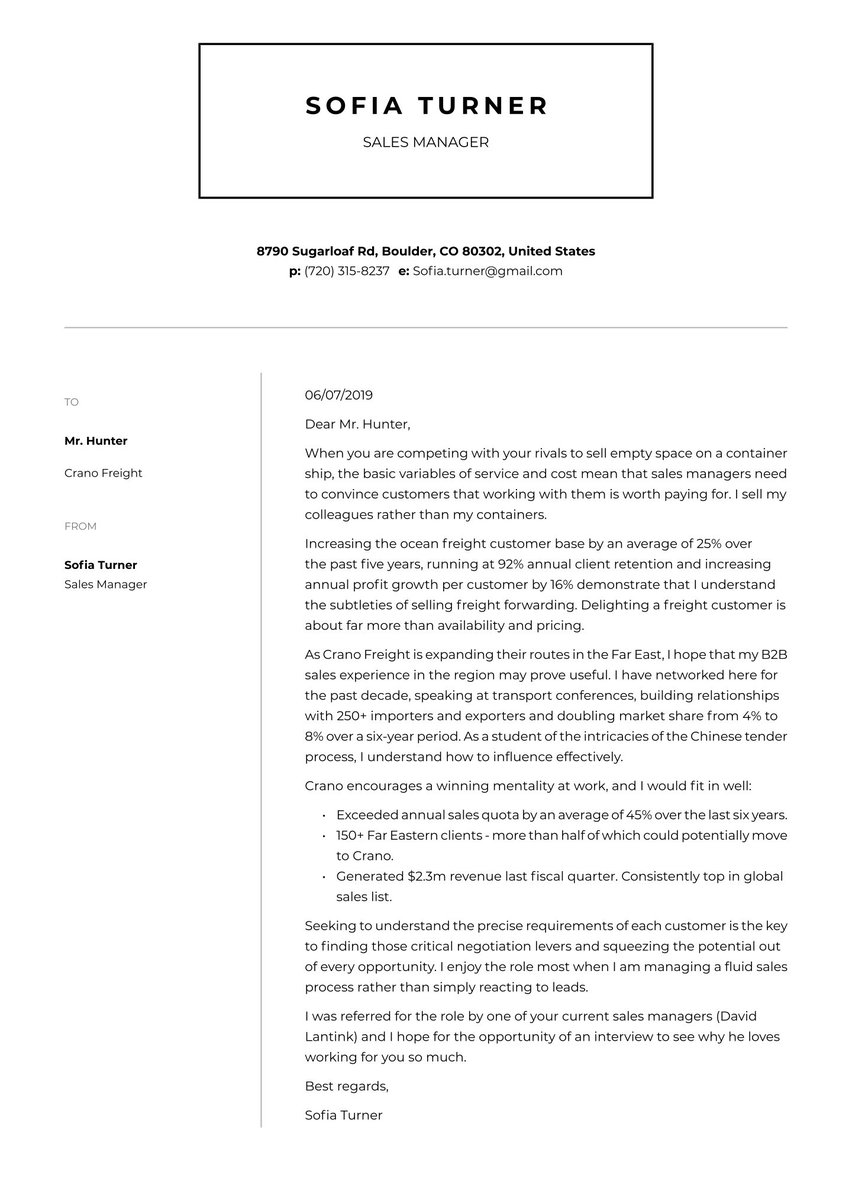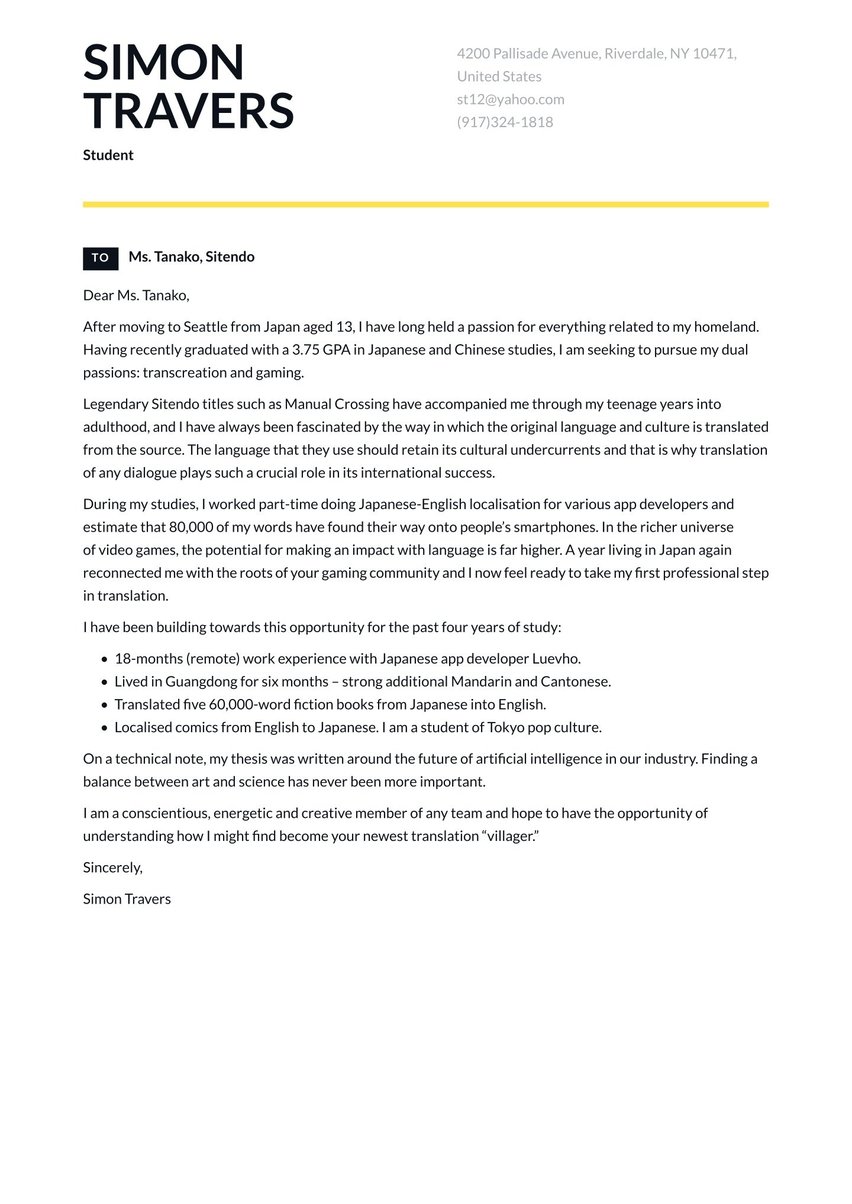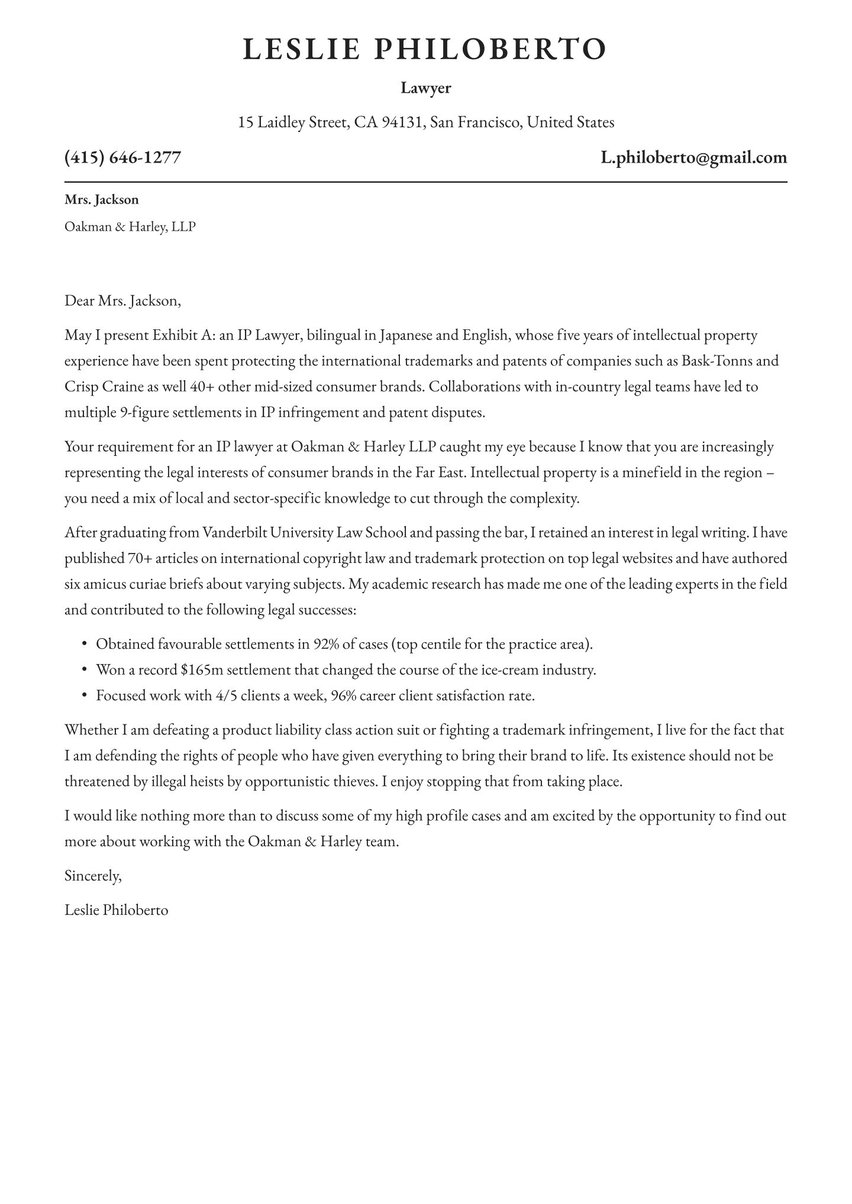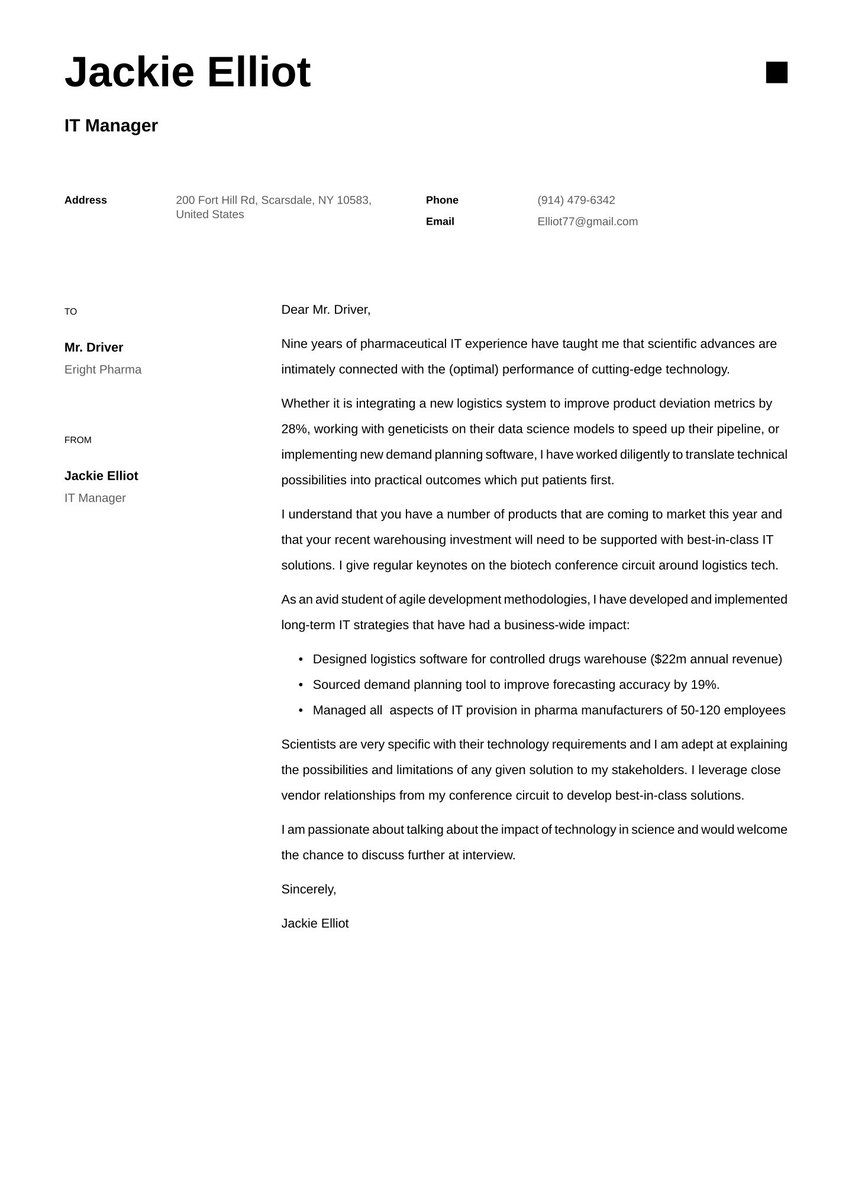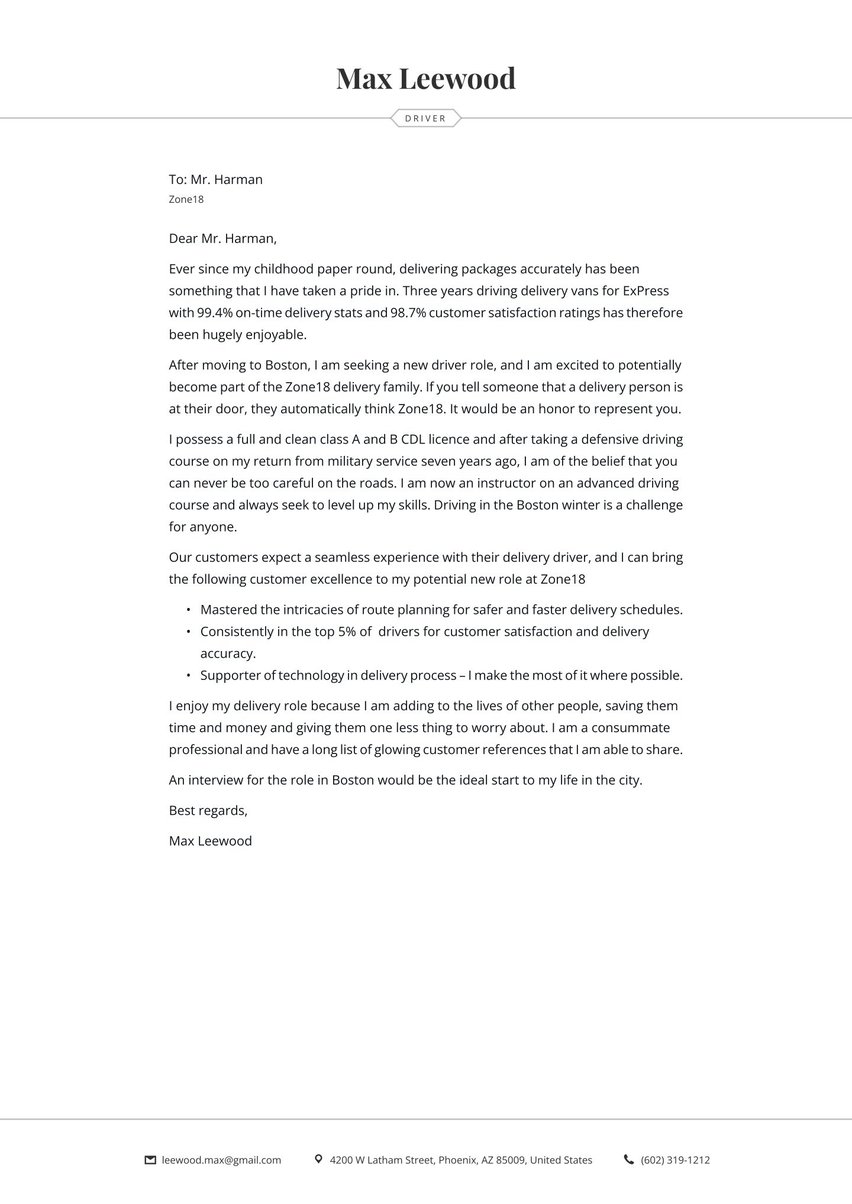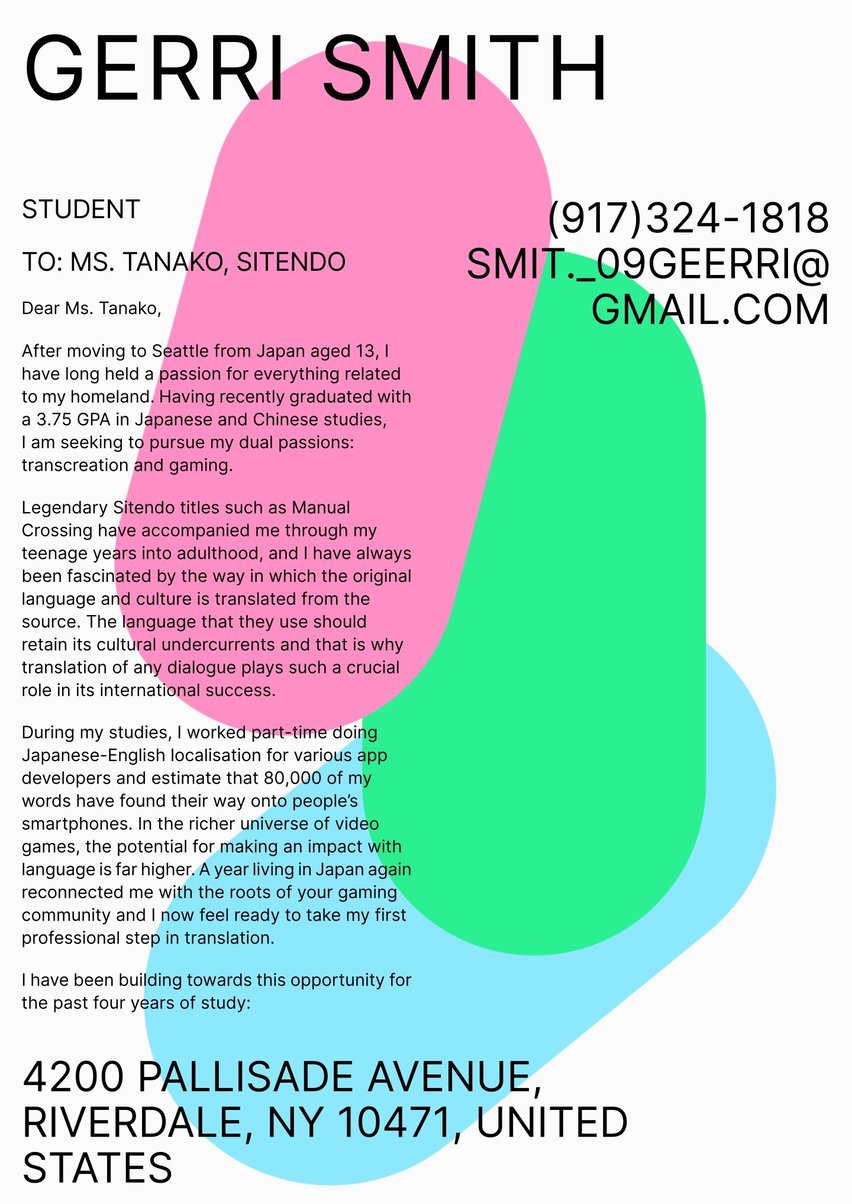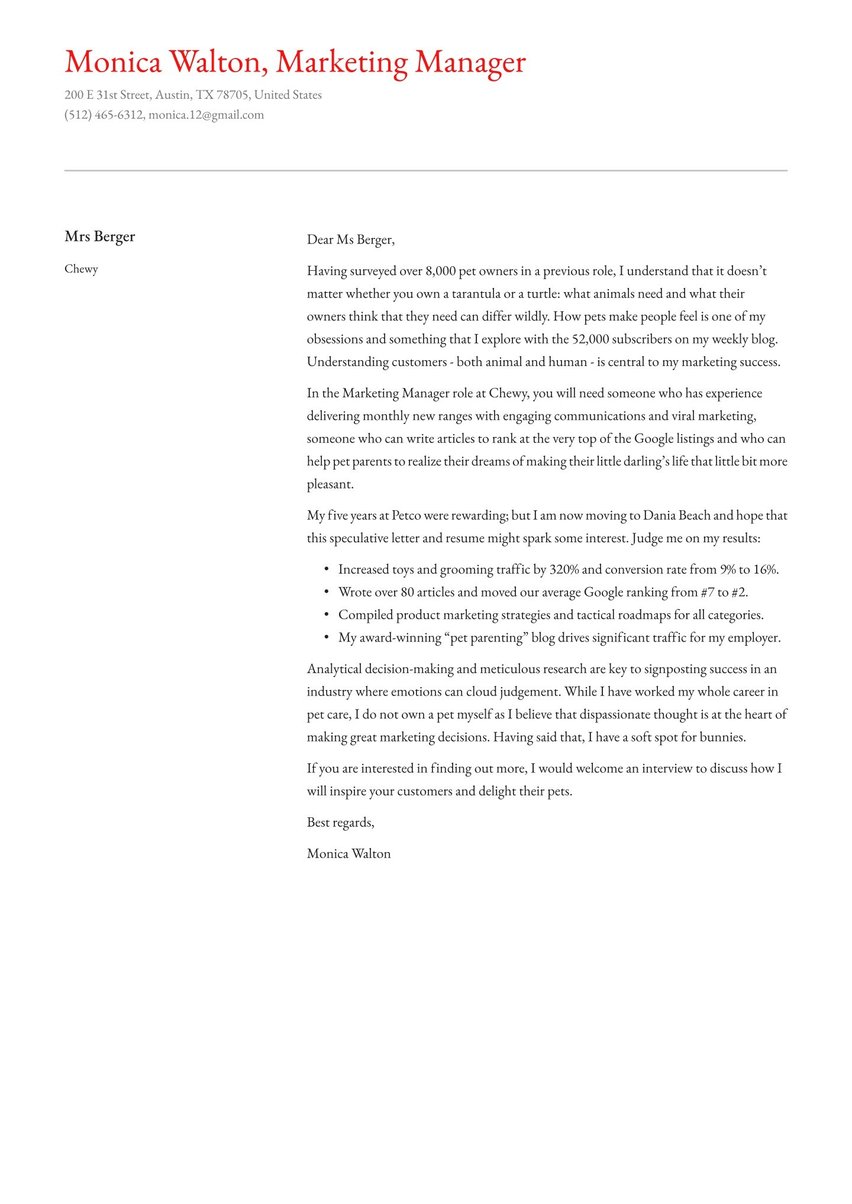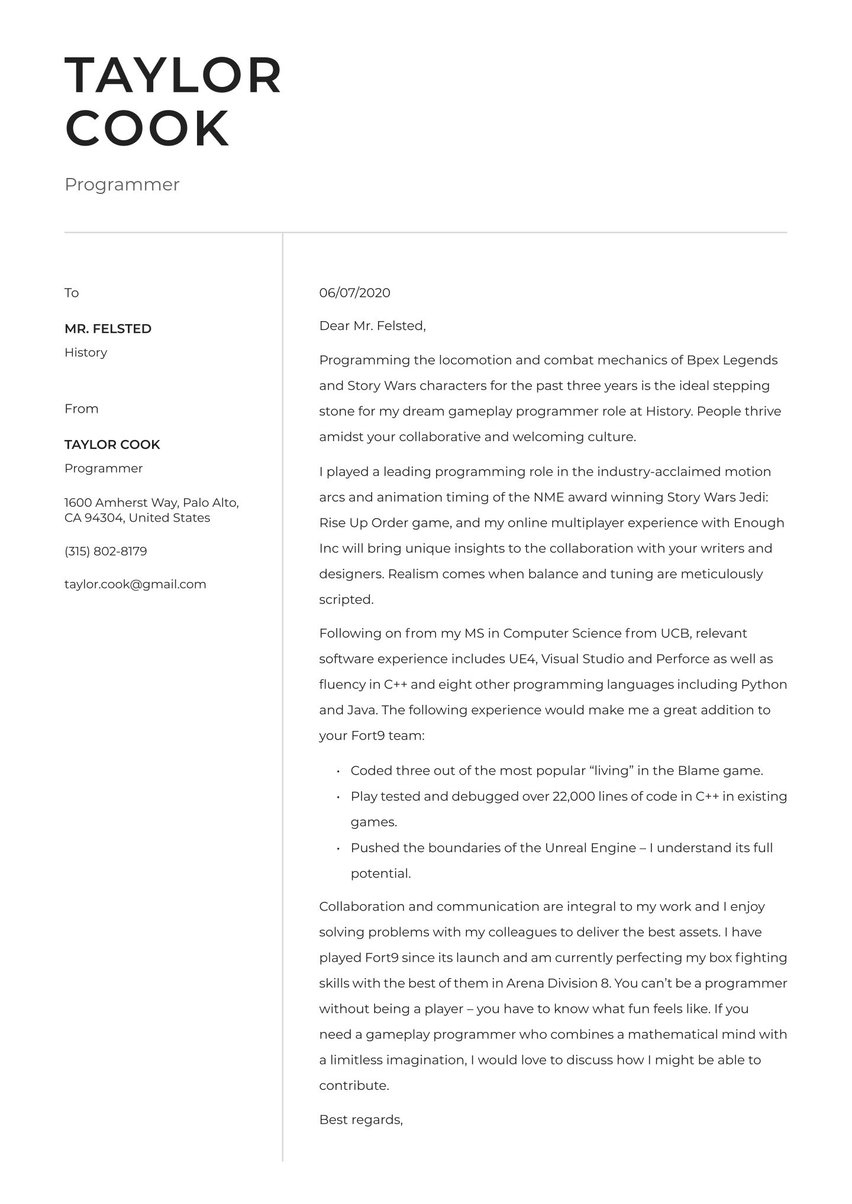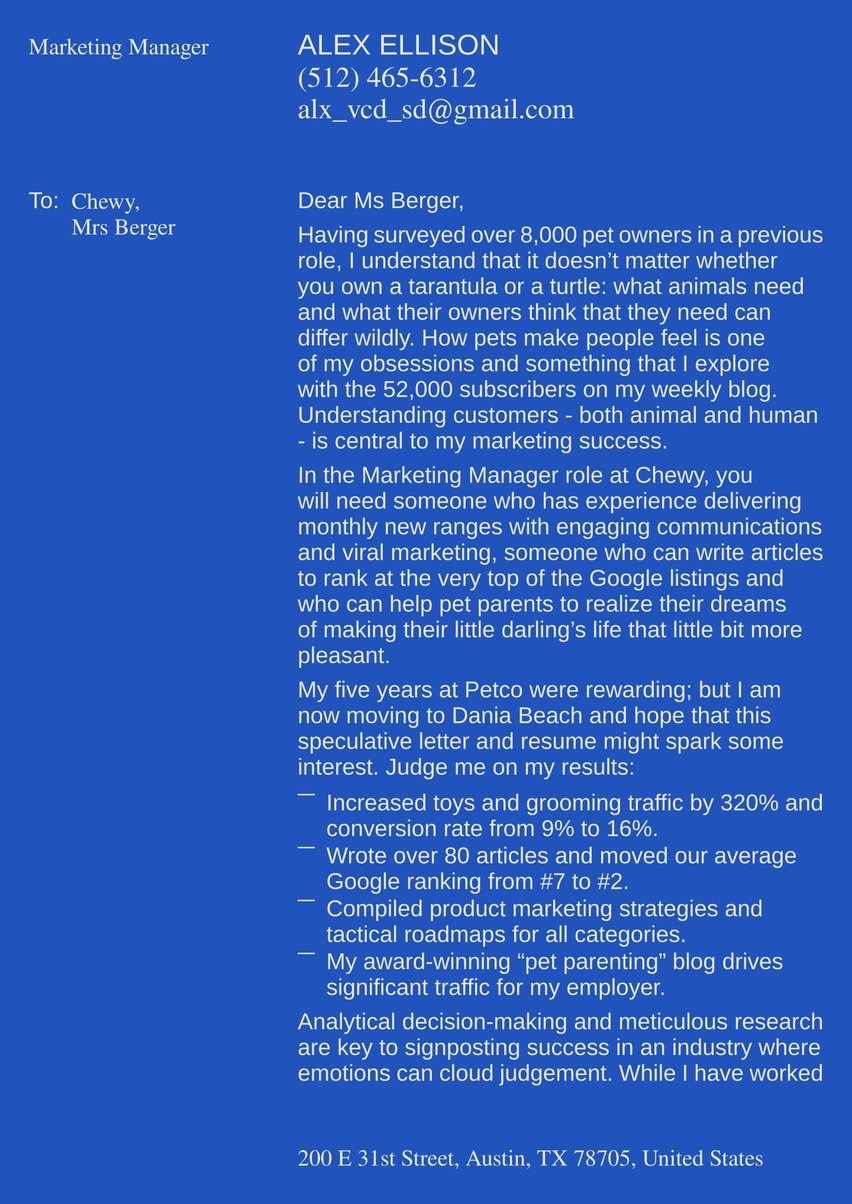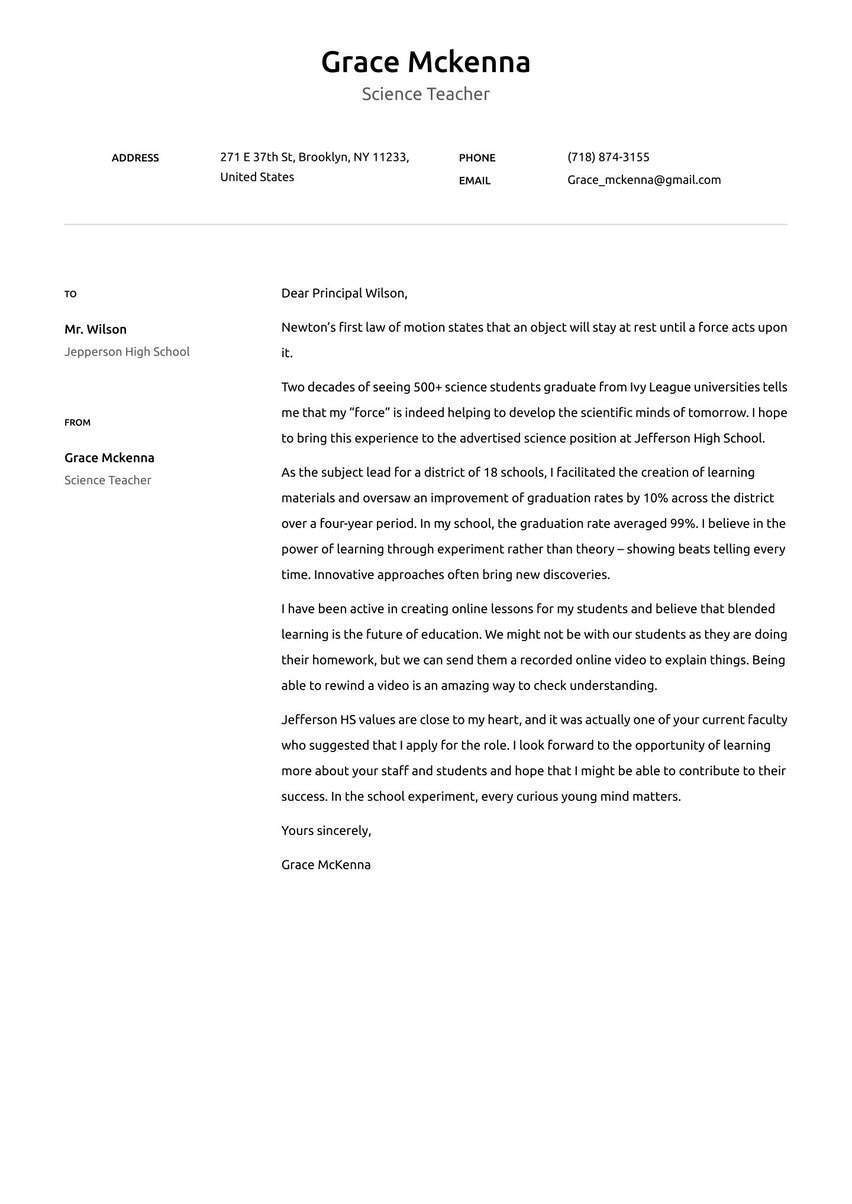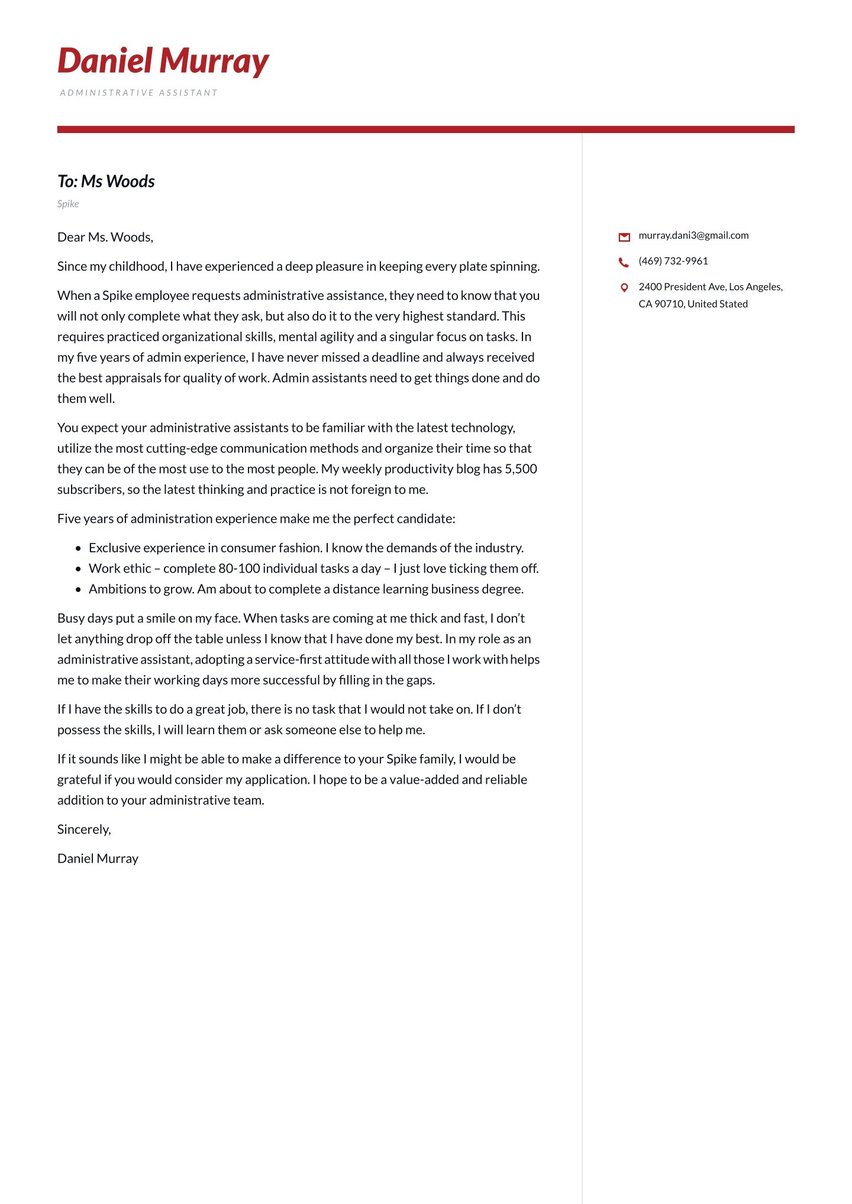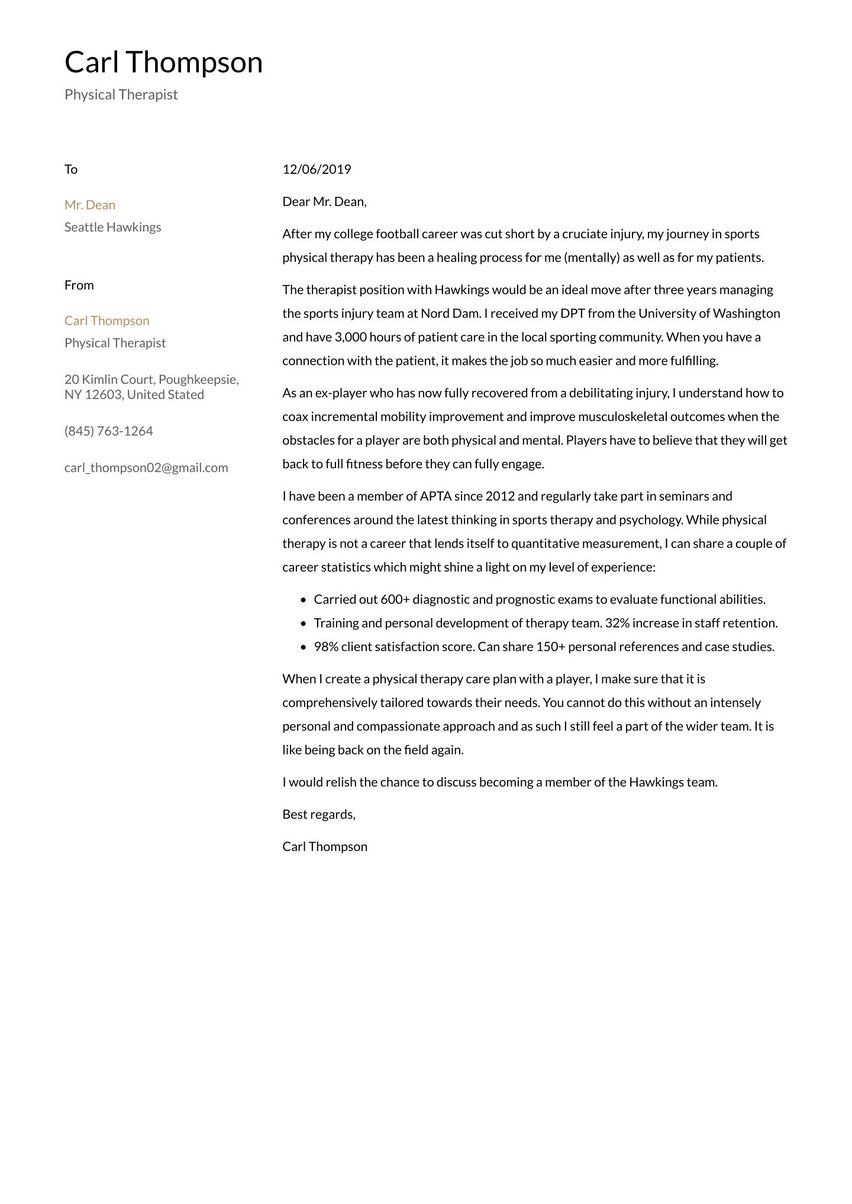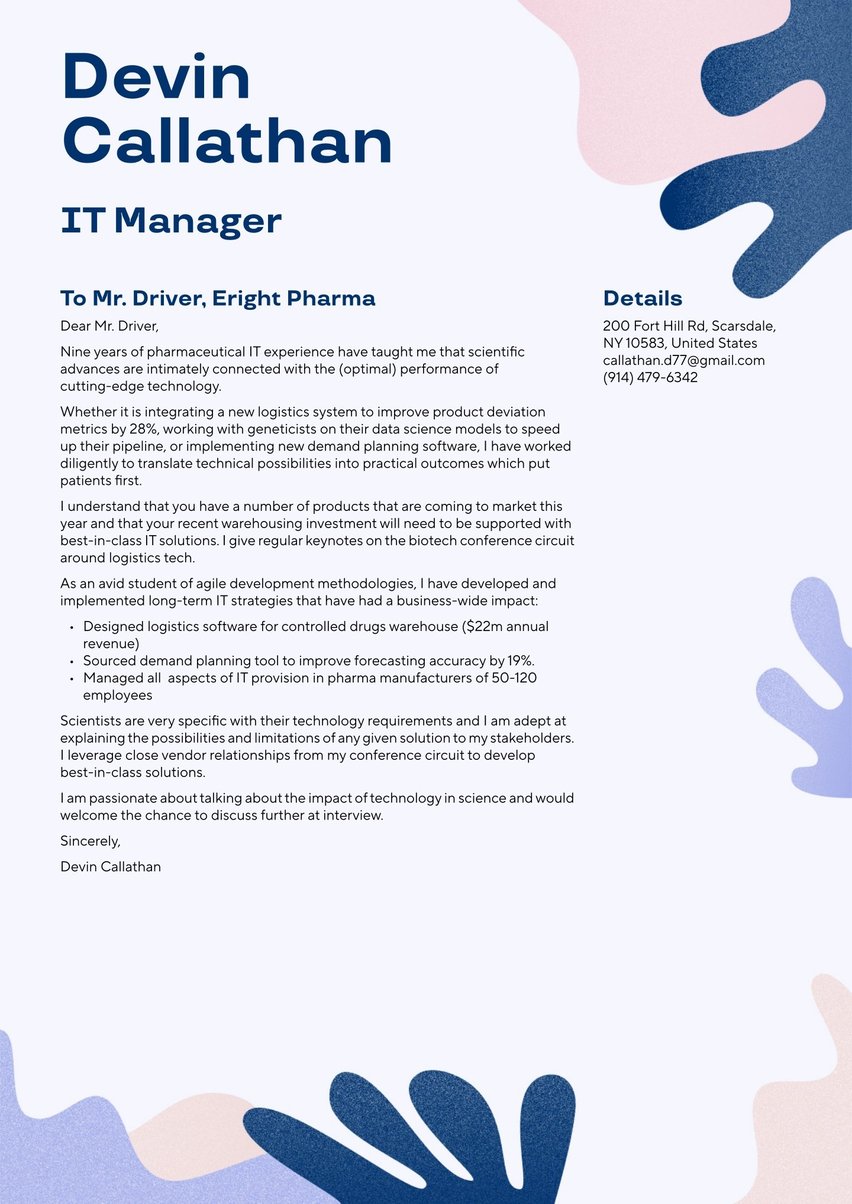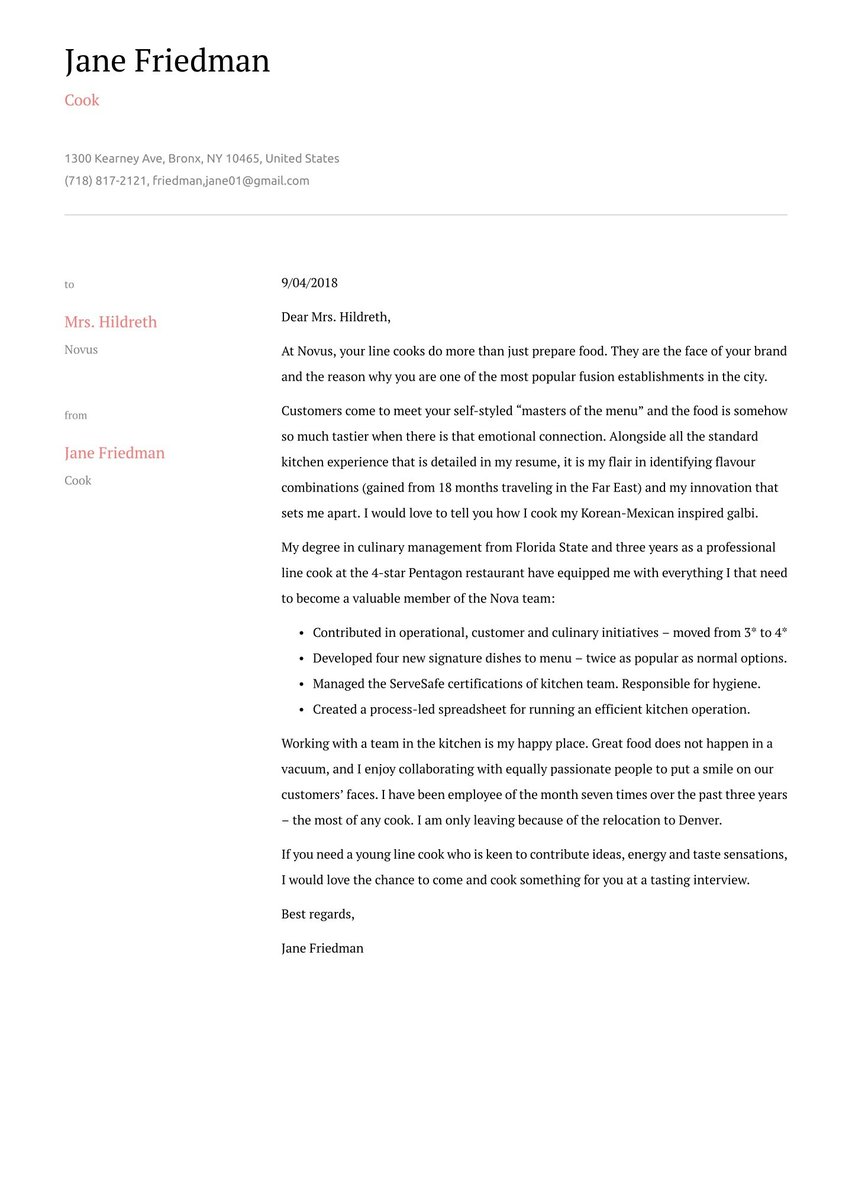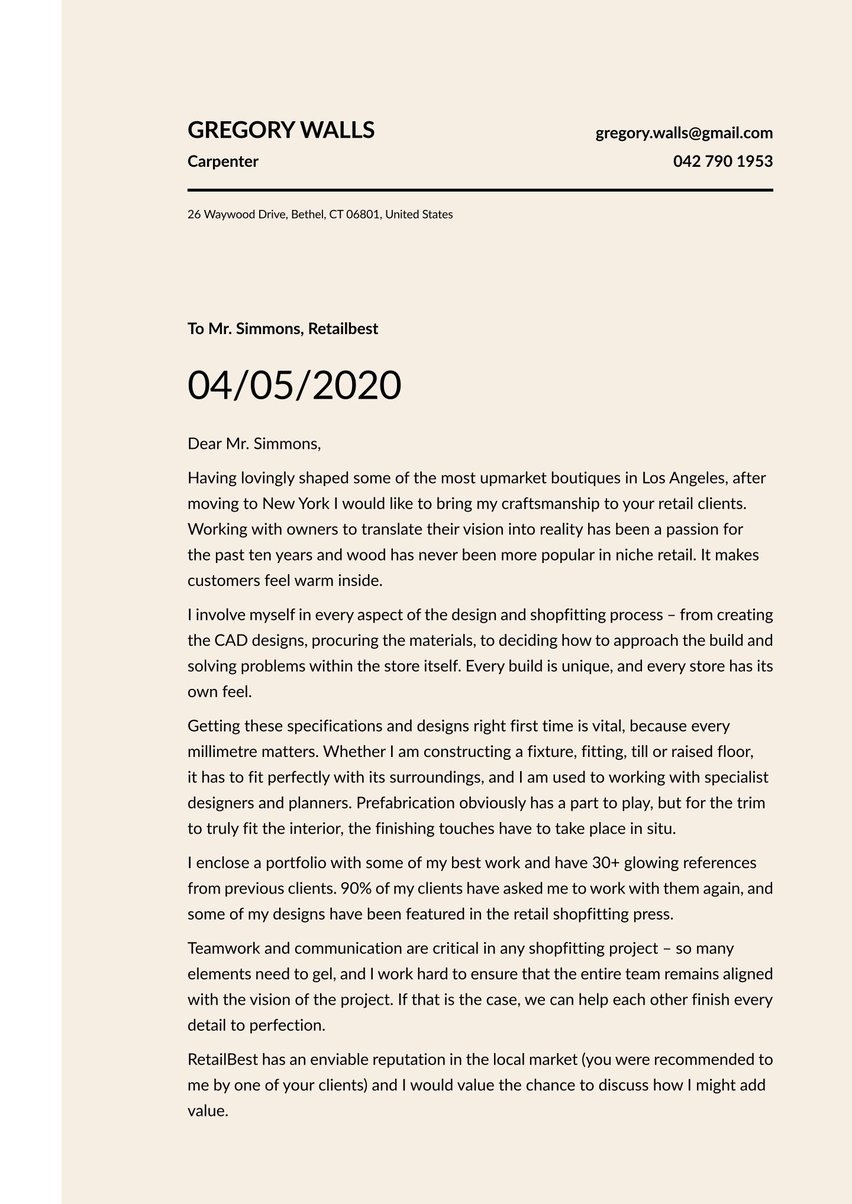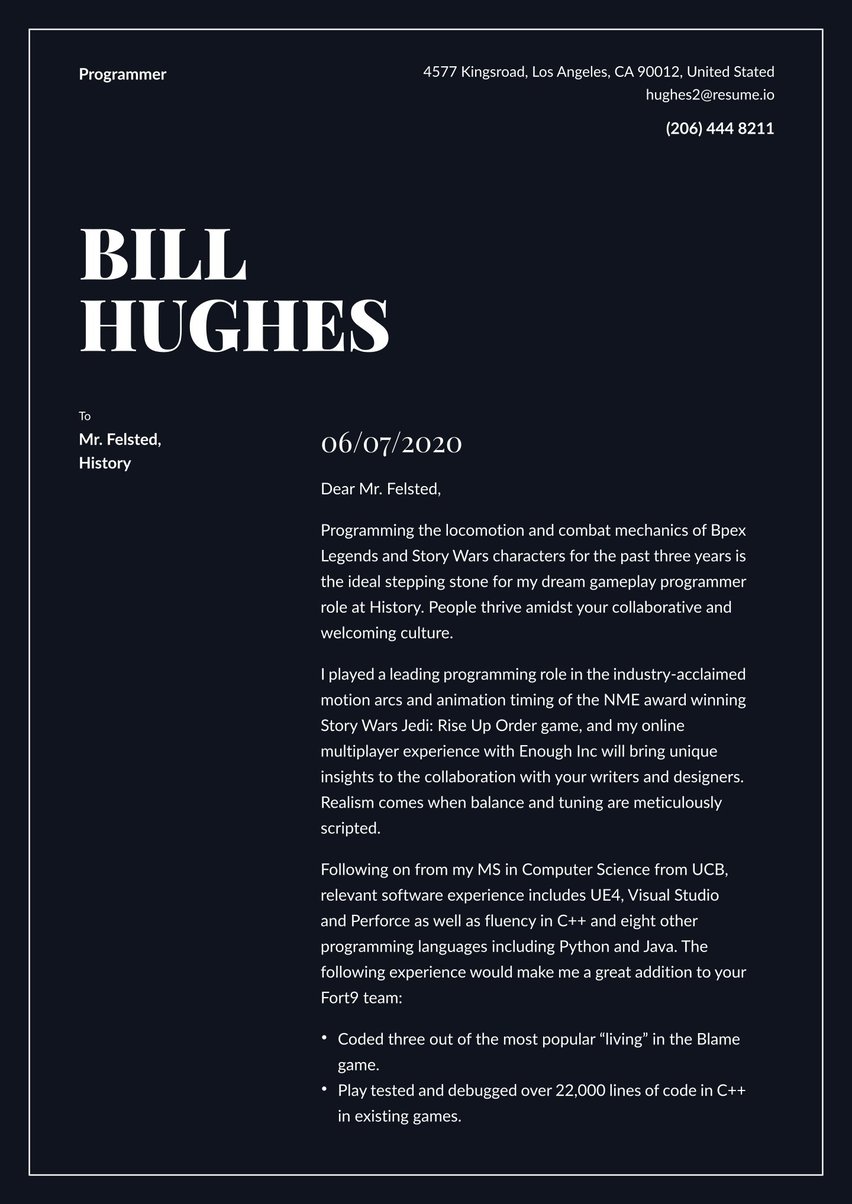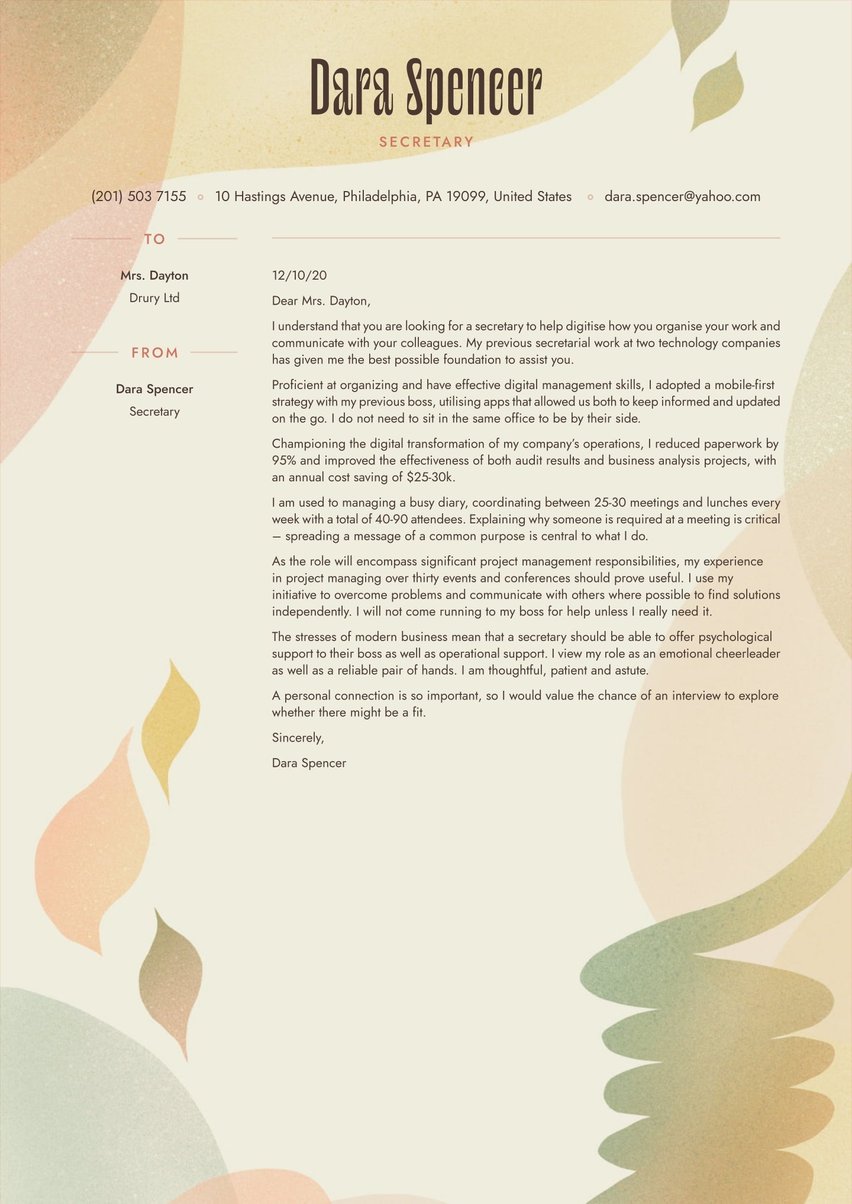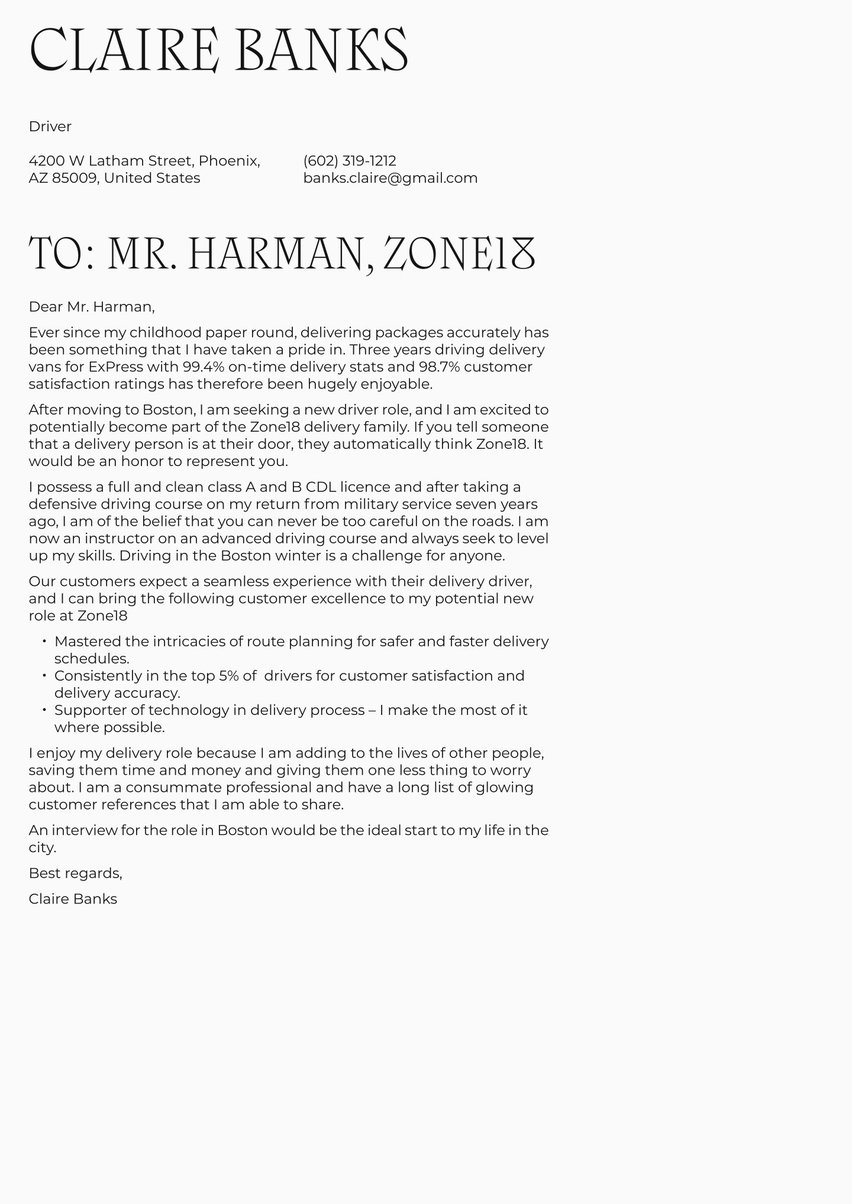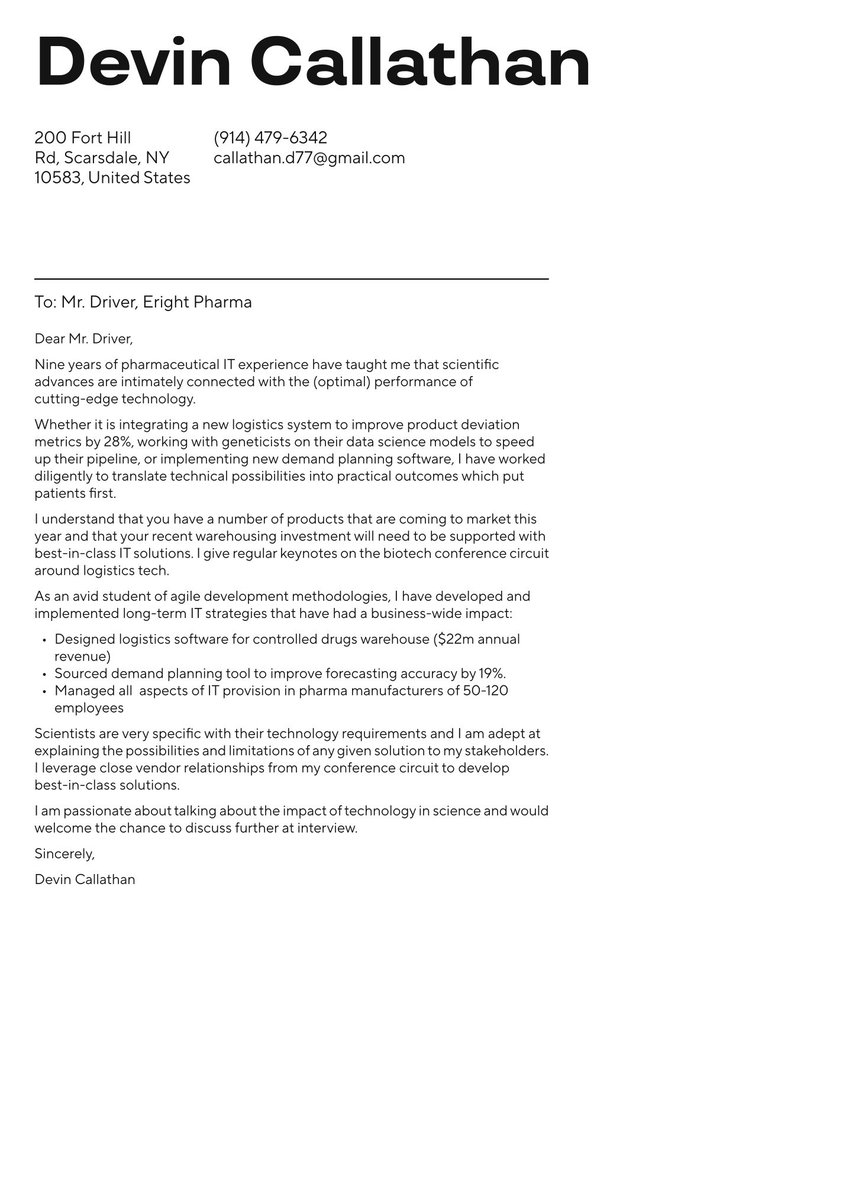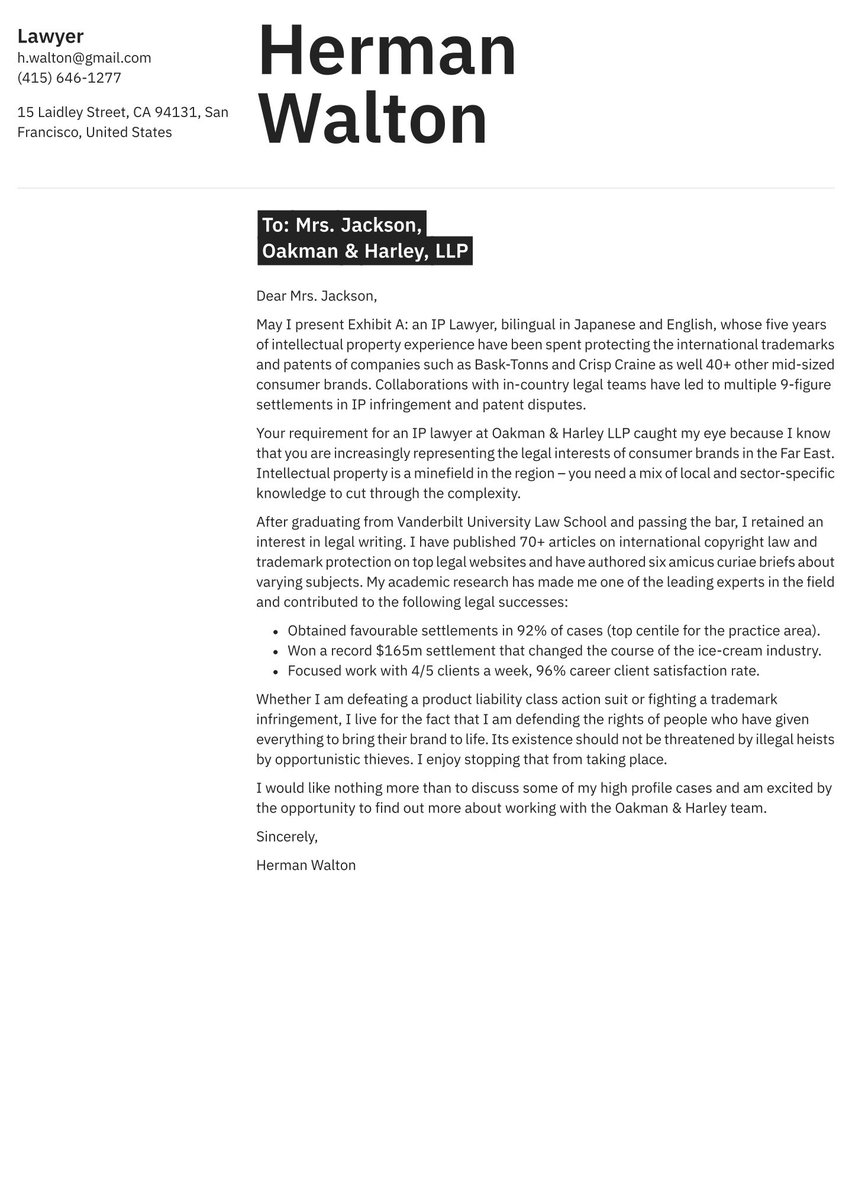While academic resumes may be somewhat longer than those of other professions, the professor cover letter still plays an important part in the application. While the faculty staff will be fascinated by your long list of research and impeccable academic credentials, they also want to know about the person they will be inviting into their staff room.
The professor cover letter allows you to share some of the personality and motivations behind your classroom inspiration. It is a place to share how you teach instead of what you teach. While the other applicants for the role may boast a similar academic record, it is your teaching approach that can set you apart.
Professor cover letter example
Dear Mrs. Roberts,
I am writing to express my strong interest in the Assistant Professor position in the Department of Psychology at the University of California, Berkeley. As a recent Ph.D. graduate from Stanford University with a specialization in Cognitive Psychology, I am confident that my research expertise, teaching experience, and commitment to academic excellence make me a strong candidate for this role.
During my doctoral studies at Stanford, I conducted extensive research on the neural mechanisms underlying memory formation and retrieval. My dissertation, which was funded by a prestigious National Science Foundation grant, investigated the role of the hippocampus in encoding and consolidating complex memories. This work has resulted in multiple publications in top-tier journals such as Nature Neuroscience and Journal of Cognitive Neuroscience, and has been presented at major conferences, including the Annual Meeting of the Cognitive Neuroscience Society.
In addition to my research achievements, I have a strong track record of excellence in teaching. As a teaching assistant at Stanford, I have taught undergraduate courses in Cognitive Psychology, Research Methods, and Statistics. I have consistently received outstanding evaluations from my students and have been recognized with the Stanford Teaching Award for my ability to engage students and facilitate their learning.
I am particularly drawn to the University of California, Berkeley's reputation for academic excellence and its commitment to groundbreaking research in psychology and neuroscience. I am excited about the opportunity to contribute to the department's cutting-edge research and to collaborate with its renowned faculty. I am also impressed by UC Berkeley's dedication to undergraduate education and its emphasis on mentoring and advising students. I am confident that my research expertise and teaching experience would enable me to make valuable contributions to the department's mission and to inspire and support the next generation of psychologists.
I am excited about the opportunity to join the Department of Psychology at the University of California, Berkeley and to contribute to its mission of advancing psychological science and educating future leaders in the field. Thank you for considering my application. I would welcome the opportunity to discuss further how my research expertise, teaching experience, and commitment to academic excellence and diversity would enable me to make a positive impact as an Assistant Professor in your department.
Sincerely,
William Taylor
Sections of a professor cover letter
Any educator understands the importance of structure in their lectures and seminars. You don’t jump straight into the academic gold, you need to warm the class up first. In the same way, the professor cover letter should follow a certain structure. And, by the way, there is no excuse for it being longer than one page (unlike your academic resume).
Here is a suggested structure for a professor cover letter:
- Cover letter header. Include your full name, email, and mobile. Repeat these contact details from the resume. You never know when you may be invited to interview.
- Greeting. Make sure that you get the academic title of the hiring manager correct. Check the job description or look on the college website. Titles matter when you work in academia.
- Introduction. Begin the professor cover letter with the topic that you will bring to the role. Lead with research if that is important for the role or start with a story about your academic credentials if the role is more teaching-led.
- Body. The body of the cover letter is where you can expand on a couple of your notable achievements. Employers will likely take a deep dive into your research, so don’t forget to include a little personality. They are also interested in what sort of colleague you will be.
- Conclusion. End with something that will stick in the hiring manager’s mind. Maybe you have impressive research or an unforgettable academic statistic about your students. Don’t forget to say that you are looking forward to understanding more about the role – curiosity is what you do best.
- Signature. Finish with an e-signature and a suitable sign-off such as “Sincerely.” You may consider an ink signature if you deliver the letter in person.
Every section of your cover letter should contain different parts of your academic journey that you wish to expand upon during an interview.
A one-page cover letter is standard for any industry or function. While your academic resume (CV) might be longer due to copious amounts of research and academic writing, there is no reason to write a longer cover letter. Brevity is the soul of wit.
Need more inspiration? View our other related cover letter examples from academia:
Writing a cover letter is more involved that just telling a couple of your stories. There are more choices to make than you might think. Read our article on how to write a cover letter.
After creating the header and addressing the hiring manager, it’s time to grab their attention.
Introduction of a professor cover letter
The most important consideration at the start of a cover letter is that you should share the stories that you wish to continue during an interview. Make sure that they are relevant to the specific demands of the role and make them impactful enough to compel the hiring manager to read on. How you start a cover letter will set the tone for the rest of your application.
Look at the research priorities of the university. How does their curriculum differ from what you have taught previously? Is there a fit in terms of the culture of the university or college? What are the political leanings of the university staff? There are many more similar questions that you might ask yourself in order to discern your unique advantage.
Dear Mr. Wilkins,
I am writing to express my interest in the professor position in the Department of History at Cornell. With a Ph.D. in Modern European History from Stanford and a proven track record of scholarly research, including publications in top-tier journals such as The Journal of Modern History, I am excited to contribute to your esteemed institution's academic community.
Hi,
Teaching students is what I am paid to do, but I much prefer hiding away in the library and researching my favourite subject. Some academics are not meant to be in the classroom. Judge me on my research papers rather than my teaching references – none of the students want to be there, anyway.
Share your passion for your subject from those very first few lines. If your introduction cannot excite an academic hiring manager, it is unlikely that your students will be enthused.
Dear Mrs. Roberts,
I am writing to express my strong interest in the Assistant Professor position in the Department of Psychology at the University of California, Berkeley. As a recent Ph.D. graduate from Stanford University with a specialization in Cognitive Psychology, I am confident that my research expertise, teaching experience, and commitment to academic excellence make me a strong candidate for this role.
Professor cover letter body
Writing the cover letter body should not be difficult for a professor. Choosing what to write may be. Here are a few ideas from the broader recruitment industry that may be relevant for your situation.
- Your cover letter should complement your resume. Don’t duplicate content.
- Focus on your personality, motivations and how you do your job.
- Be hyper-specific about the fit with the role in question.
First body paragraph: your suitability for the role (skills & experience)
Consider the culture of your future employer and the nature of the work that you will be doing.
- Offer insight into your academic priorities. What are the reasons behind your specialisms? How do you bring them to life for your students?
- Emphasize your teaching methods. Most professors will do their fair share of teaching What works for you in the classroom?
- Talk about the impact of your work. You should show that your students are central to your work. How do you quantify your impact on the student body?
Hop onto the website of your future employer. Find out more about them and adapt the language in your cover letter to match theirs, if possible. Check out some of the work of your future colleagues. You need to present yourself as “one of them.”
Second body paragraph(s): academic rigor
When reading a page of writing from an academic, the sophistication of your arguments should shine through. If you do not take care to craft the cover letter for each role you may run the risk of not being taken seriously. While you may not have spent too much time on the letter because you consider it unimportant, how can a hiring manager know that you are capable of more?
During my doctoral studies at Stanford, I conducted extensive research on the neural mechanisms underlying memory formation and retrieval. My dissertation, which was funded by a prestigious National Science Foundation grant, investigated the role of the hippocampus in encoding and consolidating complex memories. This work has resulted in multiple publications in top-tier journals such as Nature Neuroscience and Journal of Cognitive Neuroscience, and has been presented at major conferences, including the Annual Meeting of the Cognitive Neuroscience Society.
In addition to my research achievements, I have a strong track record of excellence in teaching. As a teaching assistant at Stanford, I have taught undergraduate courses in Cognitive Psychology, Research Methods, and Statistics. I have consistently received outstanding evaluations from my students and have been recognized with the Stanford Teaching Award for my ability to engage students and facilitate their learning.
I am particularly drawn to the University of California, Berkeley's reputation for academic excellence and its commitment to groundbreaking research in psychology and neuroscience. I am excited about the opportunity to contribute to the department's cutting-edge research and to collaborate with its renowned faculty. I am also impressed by UC Berkeley's dedication to undergraduate education and its emphasis on mentoring and advising students. I am confident that my research expertise and teaching experience would enable me to make valuable contributions to the department's mission and to inspire and support the next generation of psychologists.
Call to action & conclusion: finish off strong
Sum up your cover letter in the final few lines and leave a good impression. The hiring manager will be curious to find out more about you during an interview, so mention that you are also curious to see whether there is a mutual fit.
I am excited about the opportunity to join the Department of Psychology at the University of California, Berkeley and to contribute to its mission of advancing psychological science and educating future leaders in the field. Thank you for considering my application. I would welcome the opportunity to discuss further how my research expertise, teaching experience, and commitment to academic excellence and diversity would enable me to make a positive impact as an Assistant Professor in your department.
Sincerely,
William Taylor
End by signing off with your name. End with a formal sign-off, along the lines of, “Sincerely.” Formality should be observed wherever possible.
Key takeaways
A professor cover letter should mention your relevant skills, but it is your personality, academic approach, and motivations that can shine through in your cover letter.
Try our cover letter builder to experiment with the look and content of the cover letter.


